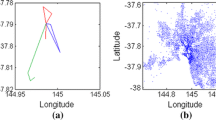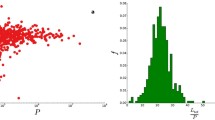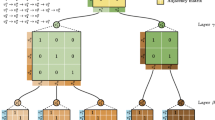Abstract
This paper reviews the progress that has been made over the last half-century in modeling and analyzing the growth of transportation networks. An overview of studies has been provided following five main streams: network growth in transport geography; traffic flow, transportation planning, and network growth; statistical analyses of network growth; economics of network growth; and network science. In recognition of the vast advances through decades in terms of exploring underlying growth mechanisms and developing effective network growth models, the authors also point out the challenges that are faced to model the complex process of transport development.
Similar content being viewed by others
References
Albert R, Jeong H, Barabási AL (1999) Diameter of the world-wide web. Nature 401:130–131
Alperovich G, Kemp M, Goodman K (1977) An econometric model of bus transit demand and supply. The Urban Institute Working Paper No. 5032-1-4, Washington, DC
Arthur WB (1994) Increasing returns and path dependence in the economy. University of Michigan Press, Ann Arbor, Michigan
Barabási A (2002) Linked: the new science of networks. Perseus Publication
Barabási AL, Albert R (1999) Emergence of scaling in random networks. Science 286:509–512
Barankay I (2004) The political economy of transport decentralisation. Technical report, ECMT Round Table 130
Barthélemy M, Flammini A (2006) Optimal traffic networks. J Stat Mech p L07002
Bertolini L (2007) Evolutionary urban transportation planning: an exploration. Environ Plann A 39:1998–2019
Besley T, Coate S (2003) Central versus local provision of public goods: a political economy analysis. J Public Econ 87(4):2611–2637
Black W (1971) An iterative model for generating transportation networks. Geogr Anal 3:283–288
Cervero R, Hansen M (2002) Induced travel demand and induced road investment: a simultaneous equation analysis. J Transp Econ Policy 36:469–490, LSE and the University of Bath
Chen W (2004) Highway network evolution models. Master’s thesis, University of Minnesota at Twin Cities
Corbett M, Xie F, Levinson D (2007) Evolution of the second-story city: the Minneapolis Skyway System. Presented at World Conference on Transportation Research Society (WCTRS) in Berkley, July 2007
Cormen TH, Leiserson CE, Rivest RL, Stein C (1990) Introduction to algorithms. The MIT Press, Chapter 17, p 329
Csányi G, Szendröi B (2004) Fractal-small-world dichotomy in real-world networks. Phys Rev E 70
Curry L (1964) The random spatial economy: an exploration in settlement theory. Ann Assoc Am Geogr 54:138–146
de Dios Ortuzar J, Willumsen LG (2001) Modeling transport. Wiley
de Solla Price DJ (1965) Networks of scientific papers. Science 149:510–515
Demange G, Wooders M (2005) Group formation in economics: networks, clubs and coalitions. Cambridge Univ. Press
Dorogovtsev SN, Mendes JFF (2002) Evolution of networks. Adv Phys 51:1079
Economides N (1996) The economics of networks. Int J Ind Organ 14(6):673–699
Euler L (1736) Solutio problematis ad geometriam situs pertinentis. Comment Acad Sci U Petrop 8:128–140
Fullerton B (1975) The development of British transport networks. Oxford Univ. Press
Garrison WL, Marble DF (1962) The structure of transportation networks. Technical report
Garrison W, Levinson D (2005) The transportation experience: policy, planning, and deployment. Oxford Univ. Press, USA
Gastner MT, Newman MEJ (2006) The spatial structure of networks. Eur Phys J B 49:247–252
Gaudry M (1975) An aggregate time-series analysis of urban transit demand: the Montreal case. Transp Res 9:249–258
Gomez-Ibanez J, Tye WB, Winston C (1999) Essays in transportation economics and policy. The Brookings Institution, Washington, DC
Harggett P, Chorley JC (1969) Network analysis in geography. Butler and Tanner
Helbing D, Keltsch J, Molnár P (1997) Modeling the evolution of human trail systems. Nature 388:47
Hilton GW, Due JF (1960) The electric interurban railways in America. Stanford Univ. Press, Stanford
Humplick F, Moini-Araghi A (1996a) Decentralized structures for providing roads: a cross-country comparison. Policy Research Working Paper 1658. World Bank, Policy Research Department, Washington, DC
Humplick F, Moini-Araghi A (1996b) Is there an optimal structure for decentralized provision of roads? Policy Research Working Paper 1657. World Bank, Policy Research Department, Washington, DC
Jackson M, Wolinsky A (1996) A strategic model of social and economic networks. J Econ Theory 71:44–74
Jeong H, Gombor B, Albert R, Oltwai ZN, Barabasi AL (2000) The large-scale organization of metabolic networks. Nature 407:651–654
Jiang B, Claramunt C (2004) Topological analysis of urban street networks. Environ Plann E 31:151–162
Kansky K (1969) Structure of transportation networks: relationships between network geometry and regional characteristics. Univ. of Chicago Press, Chicago
Knight B (2002) Endogenous federal grants and crowd-out of state government spending: theory and evidence from the federal highway aid program. Am Econ Rev 92(1):71–92
Kolars JF, Malin HJ (1970) Population and accessibility: an analysis of Turkish railroads. Geogr Rev 60:229–246
Kopp A (2006) The political economy of transport infrastructure funds. Center for Network Industries and Infrastructure (CNI) Working Paper No. 2006-10
Krugman PR (1996) The self-organizing economy. Blackwell
Lachene R (1965) Networks and the location of economic activities. Pap Reg Sci Assoc 14:183–196
Lam L (1995) Active walker model walker models for complex systems. Chaos, Solitons Fractals 6:267–285
Lam L, Pochy R (1993) Active-walker models: growth and form in nonequilibrium systems. Comput Simul 7:534
Lämmer S, Gehlsen B, Helbing D (2006) Scaling laws in the spatial structure of urban road networks. Physica A 363:89–95
LeBlanc LJ (1975) An algorithm for the discrete network design problem. Transp Sci 9(3):183–199
Levinson D (2007) Density and dispersion: The co-development of land use and rail in london. Networks, Economics & Urban Systems (NEXUS) working paper
Levinson D, Chen W (2005) Paving new ground: a Markov chain model of the change in transportation networks and land use. In: Levinson D, Krizek K (eds) Access to destinations. Elsevier Publishers
Levinson D, Chen W (2007) Area-based models of highway growth. ASCE J Urban Plann Dev (in press)
Levinson D, Karamalaputi R (2003a) Induced supply: a model of highway network expansion at the microscopic level. J Transp Econ Policy 37:297–318
Levinson D, Karamalaputi R (2003b) Predicting the construction of new highway links. J Transp Stat 6:81–89
Levinson D, Xie F, de Oca NM (2007) Forecasting and evaluating network growth. University of Calgary, Van Horne Institute, Van Horne Institute
Levinson D, Yerra B (2006) Self organization of surface transportation networks. Transp Sci 40:179–188
Liebowitz SJ, Margolis SE (1995) Path dependence, lock-in and history. J Law Econ Organ 11:205–226
Liljeros F, Edling CR, Amaral LAN, Stanley HE, Aberg Y (2001) The web of human sexual contacts. Nature 411:907–908
Lowe J, Moryadas S (1975) The geography of movement. Houghton Mifflin Company
Marini MA (2007) An overview of coalition & network formation models for economic applications. Working Paper Series in Economics, Mathematics, and Statistics 2007/12
Mohamed A (2007) Forecasting transit network evolution. PhD thesis, University of Toronto
Mohammed A, Shalaby A, Mille E (2006a) Empirical analysis of transit network evolution: case study of Mississauga, Ontario, Canada, bus network. Transp Res Rec 1971:51–58
Mohammed A, Shalaby A, Mille E (2006b) Modeling the supply of public transit: using artificial intelligence to model the evolution of the bus transit network. Working paper
Montes de Oca N (2006) Beyond business as usual: ensuring the network we want is the network we get. Master’s thesis. University of Minnesota at Twin Cities
Montes de Oca N, Levinson D (2006) Network expansion decision-making in the twin cities. Transp Res Rec 1981:1–11
Morrill (1965) Migration and the growth of urban settlement. Lund Stud Geogr Series B Human Geogr 26:65–82
Nakicenovic N (1998) Dyanmics and replacement of U.S. transport infrastructure. In: Cities and their vital systems—infratructure, past, present and future. National Academy Press, Washington DC
Newell GF (1980) Traffic flow on transportation networks. MIT Press, Cambridge
Newman M (2003) The structure and function of complex networks. SIAM Rev 45:167–256
Oates WE (1972) Fiscal federalism. Harcourt Brace Jovanovich, New York
Peng Z, Dueker KJ, Strathman J, Hopper J (1997) A simultaneous route-level transit patronage model: demand, supply, and inter-route relationship. Transportation 24:159–181
Pred A (1966) The spatial dynamics of U.S. urban-industrial growth. The MIT Press, Cambridge, pp 1900–1914
Rimmer P (1967) The changing status of New Zealand seaports. Ann Assoc Am Geogr 57:88–100
Schelling TC (1978) Micromotives and macrobehavior. Norton, New York
Schweitzer F, Ebeling F, Rose H, Weiss O (1998) Optimization of road networks using evolutionary strategies. Evol Comput 419–438
Shapiro C, Varian HR (1998) Information rules: a strategic guide to the network econom. Harvard Business School Press
Sheffi Y (1985) Urban transportation networks: equilibrium analysis with mathematical programming methods. Prentice-Hall, Englewood Cliffs, NJ
Taaffe E, Gauthier H, O’Kelly M (1996) Geography of transportation
Taaffe E, Morrill RL, Gould PR (1963) Transportation expansion in underdeveloped countries: a comparative analysis. Geogr Rev 53:503–529
Taylor BD, Miller D (2003) Analyzing the determinants of transit ridership using a two-stage least squares regression on a national sample of urbanized areas, Research Report Number 682, University of California Transportation Center, Berkeley
Vaughan R (1987) Urban Spatial Traffic Patterns. Pion Ltd, London
Verhoef E, Rouwendal J (2004) Pricing, capacity choice, and financing in transportation networks. J Reg Sci 44(3):405–435
Weidner T (1995) Hub equilibrium in the USA airnet. Master’s thesis, University of California at Berkeley
Xie F (2005) The evolution of road networks: A simulation study based on network degeneration. Master’s thesis, University of Minnesota at Twin Cities
Xie F (2007) Validation of the model of network degeneration: a case study of the Indiana interurban network. To be presented at 54th Annual North American Meetings of the Regional Science Council (NARSC) in Savannah November 2007
Xie F, Levinson D (2007a) Jurisdictional controls and network growth. Presented at World Conference on Transportation Research Society (WCTRS) in Berkley July 2007
Xie F, Levinson D (2007b) The topological evolution of road networks. Presented at transportation research board (TRB) in Washington, DC, January 2007
Xie F, Levinson D (2007c) The weakest link: a model of the decline of surface transportation networks. Transp Res Part E (in press)
Yamins D, Rasmussen S, Fogel D (2003) Growing urban roads. Netwo Spatial Econ 3:69–85
Yang H, Bell MGH (1998) Models and algorithms for road network design: a review and some new developments. Trans Rev 18:257–278
Yerra B, Levinson D (2005) The emergence of hierarchy in transportation networks. Ann Reg Sci 39:541–553
Zhang L (2005) A simulator of network growth for network economics and policy analysis. Master’s thesis, University of Minnesota at Twin Cities
Zhang L, Levinson D (2004) A model of the rise and fall of roads. Presented March 2004 at MIT Engineering Systems Symposium
Zhang L, Levinson D (2005) The economics of transportation network growth. In: Milln PC, Inglada V (eds) Essays in transportation economics. Springer
Author information
Authors and Affiliations
Corresponding author
Rights and permissions
About this article
Cite this article
Xie, F., Levinson, D. Modeling the Growth of Transportation Networks: A Comprehensive Review. Netw Spat Econ 9, 291–307 (2009). https://doi.org/10.1007/s11067-007-9037-4
Received:
Accepted:
Published:
Issue Date:
DOI: https://doi.org/10.1007/s11067-007-9037-4




